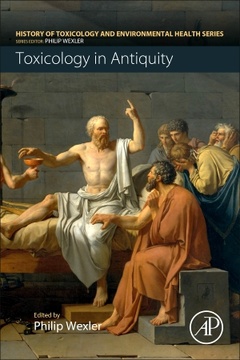Description
Toxicology in Antiquity (2nd Ed.)
Toxicology in Antiquity Volume I
History of Toxicology and Environmental Health Series
Language: English
Subject for Toxicology in Antiquity:
Keywords
Abortion; Aconite; Adultera; Alcohol; Alexander the Great; Altered states; Amanita; Amatorium; Ancient Greece; Ancient Greek history; Ancient civilization; Ancient oriental medicine; Ancient religions; Ancient warfare; Antidote; Apophis; Arrow poison; Arrow poisons; Asclepius; Bacchant; Bacchus; Baptist; Biological weapon; Bitter gourd; Bronze age; CO2; Caesar; Cakchiquel/Kakchiquel; Calcium carbonate; Carbon dioxide; Charonion; Chemical weapon; China; Christian; Classics; Cleopatra; Colchicum; Colchis; Communion; Coniine; Conium; Contraceptive; Copper mining; Copper pollution of the atmosphere; Cup-bearer; Death; Delphi; Differential diagnosis; Dildo and medicated; Dionysus; Drug; Drug therapy; Drugs; Du; Duran; Echidna; Egypt; Egyptian civilization; Ejaculate; Entheogen; Entheogens; Ethnobiology; Execution; Fray Bernardino de; Fray Diego de; Galen; Galena; Gas lake; Gate to hell; Grapevine; Greece; Greek Mysteries; Greek fire; Hades; Hannibal; Healing god; Hemlock; Herb gatherers; History of pharmacy; Hornets; Human sacrifice; Hunting; Hydrocarbon gases; Illnesses caused by lead; Immunity; India; Insects; Intoxication; Ios; Jaguar transformation; Kinds of poison; Kohl; Lead mining; Lead pollution of teeth; Lead pollution of the atmosphere; Lead sulfide; Legislation and imagination; Lex Cornelia de veneficis; Literature; Locusta
510 p. · 15x22.8 cm · Paperback
Description
/li>Contents
/li>Readership
/li>Comment
/li>
Toxicology in Antiquity provides an authoritative and fascinating exploration into the use of toxins and poisons in antiquity. It brings together the two previously published shorter volumes on the topic, as well as adding considerable new information. Part of the History of Toxicology and Environmental Health series, it covers key accomplishments, scientists, and events in the broad field of toxicology, including environmental health and chemical safety. This first volume sets the tone for the series and starts at the very beginning, historically speaking, with a look at toxicology in ancient times. The book explains that before scientific research methods were developed, toxicology thrived as a very practical discipline. People living in ancient civilizations readily learned to distinguish safe substances from hazardous ones, how to avoid these hazardous substances, and how to use them to inflict harm on enemies. It also describes scholars who compiled compendia of toxic agents. New chapters in this edition focus chiefly on evidence for the use of toxic agents derived from religious texts.
1. The Prehistory of Poison Arrows 2. Beetle and Plant Arrow Poisons of the San People of Southern Africa 3. Toxicology in Ancient Egypt 4. The Death of Cleopatra: Suicide by Snakebite or Poisoned by Her Enemies? 5. Kohl Use in Antiquity: Effects on the Eye 6. Nicander, Thêriaka, and Alexipharmaka: Venoms, Poisons, and Literature 7. The Case Against Socrates and His Execution 8. Murder, Execution, and Suicide in Ancient Greece and Rome 9. The Oracle at Delphi: The Pythia and the Pneuma, Intoxicating Gas Finds, and Hypotheses 10. Alexander the Great: A Questionable Death 11. Mithridates of Pontus and His Universal Antidote 12. Theriaca Magna: The Glorious Cure-All Remedy 13. The gates to hell in antiquity and their relation to geogenic CO2 emissions 14. Lead Poisoning and the Downfall of Rome: Reality or Myth? 15. Poisons, Poisoners, and Poisoning in Ancient Rome 16. Chemical and Biological Warfare in Antiquity 17. Asclepius and the Snake as Toxicological Symbols in Ancient Greece and Rome 18. Anthropogenic Air Pollution in Ancient Times 19. Poisoning in Ancient Rome: Images and Rules 20. “Gleaming and Deadly White: Toxic Cosmetics in the Roman World 21. Cherchez la femme: three infamous poisoners of ancient Rome 22. Did Hannibal really poison himself? 23. Drugs, Suppositories, and Cult Worship in Antiquity 24. Entheogens in Ancient Times: Wine and the Rituals of Dionysus 25. Entheogens (Psychedelic Drugs) and the Ancient Mystery Religions 26. Ancient Mystery Initiation: Toxic Priestesses and Vaginal Communion 27. Harmful Botanicals 28. Pearl, an Ancient Antidote of Eastern Origin 29. Rhetoric, Demons, and the Poisoner's Tongue in Judaism and Early Christianity 30. Poisonous Medicine in Ancient China 31. Toxicity of Ayurvedic Medicines and Safety Concerns: Ancient and Modern Perspectives 32. Mushroom Intoxication in Mesoamerica
Toxicologists, environmental health professionals, science historians, general audience
- Provides the historical background for understanding modern toxicology
- Illustrates the ways previous civilizations learned to distinguish safe from hazardous substances, how to avoid the hazardous substances and how to use them against enemies
- Explores the way famous historical figures used toxins
- New chapters focus on evidence of the use of toxins derived from religious texts
These books may interest you

Mammalian Toxicology 112.17 €



